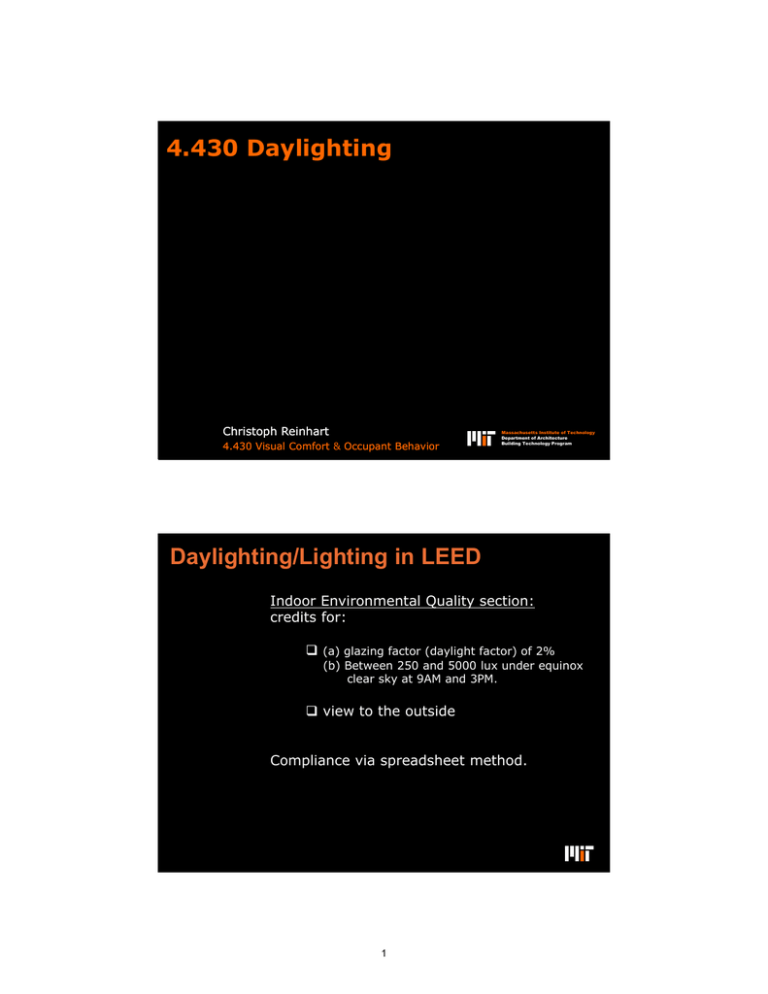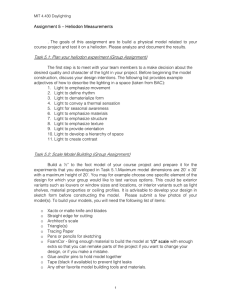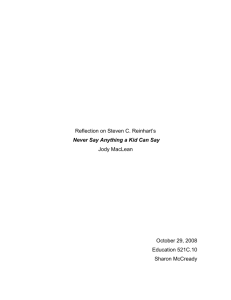4.430 Daylighting Daylighting/Lighting in LEED Indoor Environmental Quality section: credits for:
advertisement

4.430 Daylighting Christoph Reinhart 4.430 Visual Comfort & Occupant Behavior Massachusetts Institute of Technology Department of Architecture Building Technology Program Daylighting/Lighting in LEED Indoor Environmental Quality section: credits for: (a) glazing factor (daylight factor) of 2% (b) Between 250 and 5000 lux under equinox clear sky at 9AM and 3PM. view to the outside Compliance via spreadsheet method. MIT 4.430 Daylighting, Instructor C Reinhart 1 1 LEED 2.2 Glazing Factor Formula How many of you have used this formula? External obstructions are not considered. View to the Outside in LEED I Credit 8.2 Views for 90% of Spaces Achieve direct line of sight to vision glazing for building occupants in 90% of all regularly occupied spaces. Examples for exceptions copy rooms, storage areas, mechanical, laundry and other low occupancy support areas. MIT 4.430 Daylighting, Instructor C Reinhart 2 3 View to the Outside in LEED II Image by MIT OpenCourseWare. View to the Outside • Size and content matter • Information rich views with natural elements provide satisfaction and health benefits MIT 4.430 Daylighting, Instructor C Reinhart 3 4 Daylighting/Lighting in LEED Sustainable Sites: Light Pollution Credit “eliminate light trespass from the building and site, improve night sky access and reduce development impact on nocturnal environments”. Occupant Behavior MIT 4.430 Daylighting, Instructor C Reinhart 4 5 Occupant Behavior 100 blinds al ways up daylight autonomy [%] 80 US 60 40 ER B blin ds alw ays 20 0 EH A d ow VIO UR ? n, s lats ! at 4 5o blinds always fully closed 0.5 1 1.5 2 2.5 3.3 4.5 distance to facade [m] 5.5 6.5 7.5 Monitoring User Behavior architecture: Meier-Weinbrenner-Single, Nürtingen Paper: Reinhart C F, Voss K, “Monitoring manual control of electric lighting and blinds.” Lighting Research & Technology, 35:3 pp. 243-260, 2003. MIT 4.430 Daylighting, Instructor C Reinhart 5 6 Monitoring Setup in the Offices Illuminance Temperature occupancy HOBO data logger Monitoring Blind Usage video surveillance camera receiver 2414.5 MHz Blind setting MIT 4.430 Daylighting, Instructor C Reinhart data acquisition EIB system 6 7 Example Picture MIT 4.430 Daylighting, Instructor C Reinhart 7 8 switch-on probability at arrival Switch-On Probability (I) 11 type 1 0.75 0.75 0.5 0.5 0.25 0.25 type 2 00 00 100 100 200 200 300 400 500 minimum work plane illuminance [lux] minimum 600 Jim Lo Lov ve, Univ Universit ersity y of Calgary Switch-On Probability (II) switch-on probability at arrival 1 Hunt 1978 Lamparter 2000 0.75 0.5 0.25 0 0 MIT 4.430 Daylighting, Instructor C Reinhart 100 200 300 400 500 minimum work plane illuminance [lux] 8 600 9 People are Consistent but Different switch-on probability at arrival 1 0.8 0.6 0.4 0.2 0 0 100 200 300 400 minimum work plane illuminance [lux] 500 switch-offprobability probabilitywhen when leaving switch-off probability when leaving switch-off probability leaving switch-off when leaving Switch-Off Probability 11 1 0.75 0.75 0.75 no controls no controls dimmed system no controls occupancy occupancysensor sensor 0.5 0.5 0.5 0.5 0.25 0.25 0.25 0.25 000 0 minutes 1-2 hours 4-12 hours hours <30minutes minutes 1-2 hours <30 1-2 hours 4-12 hours 24+ hours 4-12 hours 24+24+ hours <30 minutes 1-2 hours 4-12 hours 24+ hours 30-59 minutes 2-4 hours 12-24 hours 30-59 minutes 2-4 hours 12-24 hours 30-59 minutes 2-4 hours 12-24 hours 30-59 minutes 2-4 hours 12-24 hours Pigg et al. University of Wisconsin behavioral patterns change in the presence of automated controls MIT 4.430 Daylighting, Instructor C Reinhart 9 10 intermediate switch-on probability Intermediate Switch-On Probability 0.03 0.02 0.01 0 0 100 200 300 400 500 600 700 minimum work plane illuminance [lux] Manual Lighting Control Algorithm blinds occlusion [%] 100 80 Lamparter 60 40 20 Inoue 0 0 1 2 solar penetration depth [m] 3 Blinds get lowered to avoid direct sunlight falling on the work plane. MIT 4.430 Daylighting, Instructor C Reinhart 10 11 Model Overview Lightswitch 2002 annual occupancy profiles annual illuminance profiles Lightswitch Algorithm (stochastic) el. lighting/blinds profile Paper: Reinhart C F, "Lightswitch 2002: A model for manual control of electric lighting and blinds", Solar Energy, 77:1 pp. 15-28, 2004 Lightswitch - Manual Lighting Control NO NO Does occupant arrive? YES NO stochasticprocess: process: stochastic switch switchon onprobability probability (F ig. 7-5) NO YES Are lights switched on? Does occupant arr ive? 1 switch-on probability NO YES Is work place already occupied? YES Does occupan t leav e? Are lights switched on? YES NO YES Does occupant leave? Hunt 0.8 Lamparter NO 0.6 NO Is there an occupancy sensor? 0.4 NO YES stochastic proces s: intermediate sw itch on probability (F ig. 7 - 7) NO stochastic process: Pigg’s switch off probability with or without occupancy sensor (Fig. 7-5) YES 0.2 0 NO0 YES 100room been 200 300 400 Has the minimum w ork plane illumiance [lux] deserted for longer than sensor delay time? NO 500 600 YES YES YES Switch lights on Switch lights off MIT 4.430 Daylighting, Instructor C Reinhart Switch lights on 11 Switch lights off 12 Lightswitch - Manual Blind Control )))))))) )))) Lightswitch - Manual Blind Control window with blinds work plane sensors Define work plane sensors that define where the occupants are usually located. Associate sensors with shading groups. A shading group consists of a (set of) blinds that are opened and lowered at the same time. Check when direct sunlight (>50Wm-2) is incident on a work plan sensor. Close shading device if yes until occupant is away for more than an hour. MIT 4.430 Daylighting, Instructor C Reinhart 12 13 Blind Use in New York City Classrooms Question 14: How often do you adjust the shading device(s)? MDesS thesis, Jennifer Sze 2009 5% 8% 17% 18% 31% 21% Multiple times a day Once or twice a week Once or twice a month Never Other N/A Image by MIT OpenCourseWare. 183 teacher surveys, 9 participating schools DIVA Demo: Occupant Behavior MIT 4.430 Daylighting, Instructor C Reinhart 13 14 Modeling Occupant Behavior No Blinds With Blinds Detecting Glare MIT 4.430 Daylighting, Instructor C Reinhart 14 15 What is glare? Glare is a subjective human sensation that describes ‘light within the field of vision that is brighter than the brightness to which the eyes are adapted’ (HarperCollins 2002). Illustration by ZStardust on Wikimedia Commons. Glare Indices A glare index is a numerical evaluation of high dynamic range images using a mathematical formula that has been derived from human subject studies. UGR 8 log10 0.25 n L2s s Lb i 1 P 2 CIE Unified Glare Rating MIT 4.430 Daylighting, Instructor C Reinhart Example indices include the unified glare rating (UGR) and the daylight glare index (DGI). All of these equations were derived from experiments with artificial glare sources – none of them under real daylight conditions. The reason for this is that until recently it has been next to impossible to collect high dynamic range images of daylit scenes under continuously changing lighting levels. 15 16 Daylight Glare Probability (DGP) Room 1: CCD Camera Room 2: Human Subject DGP is a recently proposed discomfort glare index that was derived by Courtesy of Elsevier. Used with permission. Wienold and Christoffersen from laboratory studies in daylit spaces using 72 test Weak correlation DGI and CGI (cventional galre subjects in Denmarkbetween and Germany. Two identical, side-by-sideevaluations. test rooms were used. In Room 1 a CCD camera metrics) and occupant based luminance mapping technology was installed at the exact position and orientation as the head of the human subject in Room 2. Paper: Wienold & Christoffersen, " Evaluation methods and development of a new glare prediction model for daylight environments with the use of CCD cameras ", Energy & Buildings 2006. Image-based Glare Source Detection using the Radiance evalglare Program Paper: Wienold & Christoffersen, " Evaluation methods and development of a new glare prediction model for daylight environments with the use of CCD cameras ", Energy & Buildings 2006. MIT 4.430 Daylighting, Instructor C Reinhart 17 18 In Search of a Glare Metric… Courtesy of Elsevier. Used with permission. Weak correlation between DGI and CGI (conventional glare metrics) and occupant evaluations. Paper: Wienold & Christoffersen, " Evaluation methods and development of a new glare prediction model for daylight environments with the use of CCD cameras ", Energy & Buildings 2006. 100% 100% Percentage of disturbed persons Percentage of disturbed persons In Search of a Glare Metric… 80% 60% 40% 20% 0% 2 R =0.12 0 2000 4000 6000 80% 60% 40% 20% 8000 0% 2 R =0.56 0 10 Window Luminance [cd/m2] 40 50 60 DGI + Standard deviation - 100% 100% Percentage of disturbed persons Percentage of disturbed persons 30 Daylight glare index DGI Window Luminance + Standard deviation of DGP - 80% 60% 40% 20% 0% 20 2 R =0.56 0 10 20 30 40 50 CGI Total responses: 349 Number of responses per illuminance- class:29 80% 60% 40% 20% 0% 2 R =0.77 0 2000 4000 6000 8000 10000 Vertical Eye Illuminance [lux] CGI + Standard deviation - Vertical Eye Illuminance + Standard deviation - Image by MIT OpenCourseWare. Vertical eye illuminance promising for the first term. MIT 4.430 Daylighting, Instructor C Reinhart 17 18 Final Daylight Glare Probability Metric 100% Total responses: 349 Number of responses per DGP - class: 29 Probability of disturbed persons 90% 80% 70% 60% 50% 40% 30% 20% R2 = 0.94 10% 0% 0 0.1 0.2 0.3 0.4 0.5 0.6 0.7 0.8 0.9 1 Daylight glare probability DGP DGP + _ Standard deviation of DGP + _ Standard deviation of binomial deviation Image by MIT OpenCourseWare. Paper: Wienold & Christoffersen, " Evaluation methods and development of a new glare prediction model for daylight environments with the use of CCD cameras ", Energy & Buildings 2006. DGP allows users to go back and forth between simulation and reality through HDR photography HDR Image (Digital Camera) HDR Image (Radiance) evalglare program instantaneous daylight glare probability MIT 4.430 Daylighting, Instructor C Reinhart 18 19 DGP Comfort Ranges DGP < 35% imperceptible 35% < DPP < 40% perceptible 40% <DGP < 45% disturbing DGP > 45% intolerable Example DGP Calculation MIT 4.430 Daylighting, Instructor C Reinhart 19 20 DIVA Demo: DGP Point in Time Calculation Towards Annual Glare Calculations Generated visualizations for illuminance calculation removed due to copyright restrictions. Wienold developed a process through which the annual glare calculation is split into a regular Daysim illuminance calculation and an ab=0 contrast image. Paper: J Wienold, “Dynamic Daylight Glare Evaluation”, Building Simulation 2009, Glasgow Scotland. MIT 4.430 Daylighting, Instructor C Reinhart 20 21 Comparison of Simplified DGP and hour -byhour method Graph of vertical illuminance removed due to copyright restrictions. Paper: J Wienold, “Dynamic Daylight Glare Evaluation”, Building Simulation 2009, Glasgow Scotland, 2009. Annual Glare Map MIT 4.430 Daylighting, Instructor C Reinhart 21 22 Number of working hours above DGP DGP Comfort Ranges 1500 DGPintolerable = 39% 1200 1012 hours 900 600 300 0 30 35 40 45 50 55 60 Daylight glare probability [%] Imperceptible Disturbing Perceptible Intolerable Image by MIT OpenCourseWare. Paper: C F Reinhart, Simulation-based Daylight Performance Predictions", Book chapter in Building Performance Simulation for Design and Operation, Editors J Hensen and R Lamberts, Taylor & Francis, 2011. 100 No blinds 1500 No blinds (avoid direct sunlight) 1200 900 Active blind use (avoid discomfort glare) 600 Blinds always 300 0 20 lowered 25 30 35 40 45 50 55 60 Disturbing Perceptible Intolerable Active blind use (avoid discomfort glare) 60 40 Blinds always lowered 20 0 0 1 2 3 4 5 6 7 Distance to facade [m] Daylight glare probability [%] Imperceptible Active blind use (avoid direct sunlight) 80 Active blind use Daylight Autonomy [%] Number of working hours with DGP above Expanded Blind Control Model: Close Blinds when DGP > 40% Image by MIT OpenCourseWare. 22 The formula makes sense. How plausible are DGP results compared to other glare indices? Multidirectional Time-Lapse Simulation The image shows a cylindrical 360o view of a work space in Gund Hall. The color coded lines at the bottom show the predictions of different glare indices (DGP, DGI, UGI, CGI and VCP) whether discomfort glare will be experienced in a particular direction at different times of the day (Green=Imperceptible Glare; Yellow=Perceptible Glare; Orange=Disturbing Glare; Red=Intolerable Glare). Design: Jeff Niema Paper J A Jakubiec, C F Reinhart, “The Use of Glare Metrics in the Design of Daylit Spaces: Recommendations for Practice", submittedsz to Lighting Research and Technology 2011. MIT 4.430 Daylighting, Instructor C Reinhart 23 24 Multidirectional Time-Lapse Simulation DGP yields most plausible results in these spaces. Design: Jeff Niema Paper sz J A Jakubiec, C F Reinhart, “The Use of Glare Metrics in the Design of Daylit Spaces: Recommendations for Practice", submitted to Lighting Research and Technology 2011. How to analyze for visual discomfort? Paper: J A Jakubiec, C F Reinhart, 2010, “The Use of Glare Metrics in the Design of Daylit Spaces: Recommendations for Practice", Lighting Research and Technology, 2011. MIT 4.430 Daylighting, Instructor C Reinhart 24 25 Multidirectional Time-Lapse Simulation DGP yields most plausible results in these spaces. Design: Jeff Niema Paper sz J A Jakubiec, C F Reinhart, “The Use of Glare Metrics in the Design of Daylit Spaces: Recommendations for Practice", submitted to Lighting Research and Technology 2011. Concept of the Adaptive Zone Annual DG Calculation: Fixed view looking forward Annual DG Calculation: +/‐ 45 degrees rotational freedom The concept helps to quantify the benefits of flexible furniture settings etc. Design: Jeff Niema Paper sz J A Jakubiec, C F Reinhart, “The Use of Glare Metrics in the Design of Daylit Spaces: Recommendations for Practice", submitted to Lighting Research and Technology 2011. MIT 4.430 Daylighting, Instructor C Reinhart 25 26 The Ultimate Adaptive Space Christoph Reinhart Associate Professor MIT 4.430 Daylighting, Instructor C Reinhart email: creinhart@mit.edu 26 27 MIT OpenCourseWare http://ocw.mit.edu 4.430 Daylighting Spring 2012 For information about citing these materials or our Terms of Use, visit: http://ocw.mit.edu/terms.

